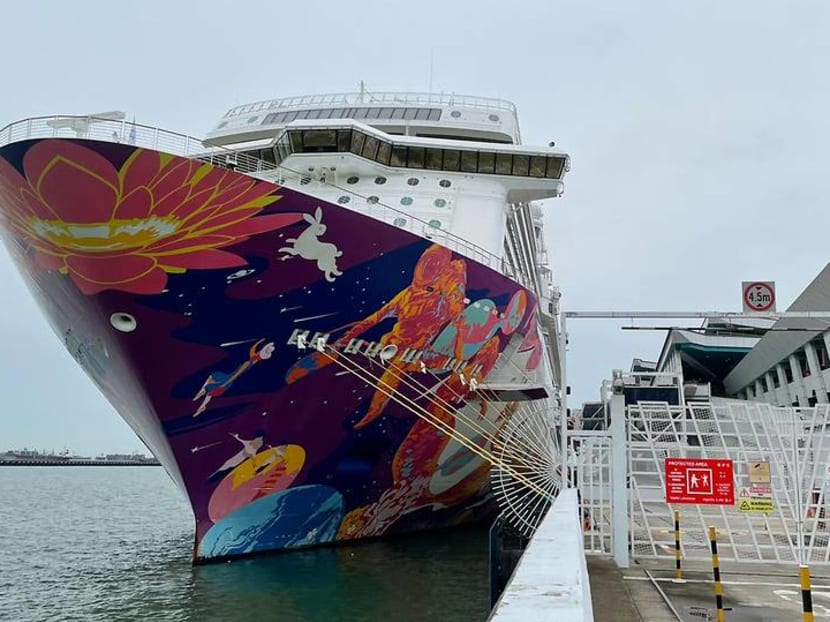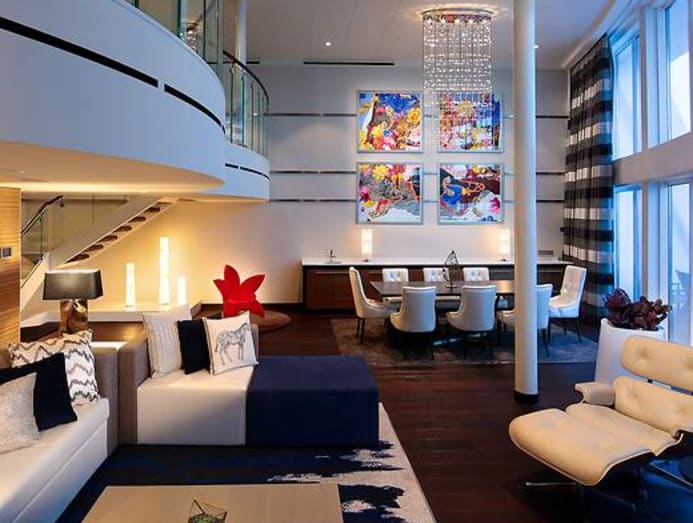Commentary: Why a boring cruise to nowhere might be just the thing you need
After a travel drought of two long years, there was a chance at a holiday via any of the 27 vaccinated travel lanes. But some, like CNA’s Crispina Robert, decided to stick to safer seas – by going on a cruise to nowhere.

SINGAPORE: It’s an odd kind of irony when you want to escape the cabin fever of being cooped up in your home, and on a tiny island, by checking into a small cabin for a few days.
Yet, that’s what hundreds of thousands of us have done after two cruise lines, Royal Caribbean and Dream Cruises, were given the green light to operate cruises to nowhere since the start of the pandemic.
Catering only to Singapore residents, there are no port of calls (for now), capacity is halved, vaccinations and antigen tests are a must.
Despite more vaccinated travel lanes being opened in the last six months, the demand for cruising has not let up. According to Royal Caribbean International, the company’s cruises to nowhere are selling fast for this year.
Cruise lines are seeing repeat visitors, showing that people’s experience on board, despite COVID-19 restrictions, was good enough for them to book again and even take along others who have never been on cruises their entire lives.
CRUISES HAVE THEIR HATERS
Now, getting on a cruise doesn’t sound like something all of us want to do. It’s so much better to get on a plane and jet off to Korea or Bangkok.
Many people hate the idea of cruising. They simply cannot imagine being stuck on a ship for days.
The most common anti-cruise sentiments are down to a few reasons: Getting sea-sick, being trapped in a small room for days with “nothing to do”, the set eating times and the activities which are mass marketed, the fact that you have to share pools and saunas with hundreds of others, and the ever-present fear of someone testing positive for COVID-19 which would lead to an immediate turnaround.
This nightmare scenario unfolded in July 2021 when a Dream Cruise ship had to come back early because someone on board was a close contact of a COVID-19 case – this was at the height of the KTV cluster in Singapore. Due to strict protocols, everyone had to wait for hours just to disembark safely.
When it came time to plan an annual holiday last year, my family decided flying anywhere was just too costly because of the countless tests.
But the biggest deal breaker was the fact that there was too much uncertainty. As we’ve seen in just the last few weeks, a vaccinated travel lane arrangement can be completely upended, and borders can shut.
Plus, the thought of being in a country where cases spiral filled me with anxiety and it didn’t sound like a relaxing holiday – far from it.
Yet, travel-starved for two years and unconvinced a staycation would do the trick, I thought a cruise seemed a decent compromise. To be honest, no one in the family seemed keen but everyone agreed it was better than nothing.
PRECONCIEVED NOTIONS
Thinking I would be bored out of my mind, I furiously downloaded several shows and a couple of books, brought along two bottles of wine and my Bluetooth keyboard. It was disorienting to go on a “holiday” where our time was not filled to the brim with things to do.

As it turns out, I didn’t get to all those things. I didn’t need to. Once we cleared our pre-departure tests (which involved a tedious wait of about an hour and a half), things began looking up.
A nifty app that cruise passengers are encouraged to download tells you all you need to know about what the activities are and what’s being served in each of the many restaurants.
It was unexpectedly pleasant not to have to plan where to go, what to eat or how to navigate a city – which is what I would have done on a normal holiday.
In pre-COVID times, organising a family trip can be quite a nightmare when everyone has different interests or meal or nap time preferences, and just deciding on where to eat can mean hours of discussion and the inevitable sullen compromise on someone’s part.
Restaurants are open at the crack of dawn and stay that way throughout the day, so you simply show up, take a quick walk around and put something half decent on your plate.
Grandma can head out to eat first if she’s up at 6am; for the teenager who rises at noon or sleeps at 2am, there’s always hot pizza to be had.
The only work your brain needs to do is decide which activities to take part in. Cruise operators know they have a captive audience so there are things happening on the hour every hour.
There’s something for everyone and the best activities are catered to the older and younger crowds. Children have organised treasure hunts and simulated surf rides while adults can try their hand at Bingo or take part in an art auction.
For those neither too young nor old, there could have been more. For instance, line dancing, origami or a towel folding courses were mainstays.
It’s one thing to come back to the cabin to see a perfectly folded elephant or monkey (which I gently put away not quite knowing what to do with it) but it seemed rather pointless to learn how to do it.
Perhaps COVID-19 had a stymying effect on how fun activities could be. For instance, a soccer game morphed into a sport of people standing 1m apart in their masks lining up to take a shot at goal.
Bumper car rides lasted less than 5 minutes and became an activity for parents accompanying toddlers rather than slightly drunk adults hell bent on crashing into each other.
Needless to say, most passengers descended on the pool. And because cruises are wildly popular with families, the swimming pools were swarming with children and parents shouting after them.
Thankfully, an entire section of the ship was closed off to anyone under 16, and we spent the bulk of our time sitting by the sun beds there.
DISCONNECTING INTENTIONALLY
One of the biggest changes to people’s lives on the back of this pandemic has been the blurring of work and personal time, giving rise to conversations (even in Parliament) about the right to disconnect.
Companies have to confront this issue head on: Burnout is real, and people need time to step away from the cult of a 24/7, “always on” work culture.
On a regular land holiday, you can’t quite navigate a new country without maps or search for dining or lodging options without a good internet connection. Which is why getting data sorted was the first order of business for any of us in pre-COVID travel.

But on a cruise, you don’t really need your daily digital devices. Some of my friends refused to pay for connection and remained blissfully uncontactable – a forced digital detox without WhatsApp messages or email notifications pinging away incessantly.
Stripped of this ball and chain, all one has is time. The day is completely at your disposal to do as you wish. In that spirit, I did exactly nothing. In a world where fear of a virus affects so many parts of our lives, that small sliver of freedom – like the endless blue of the ocean – was quite a welcome pause.
In the end, we spent time playing games, reading, having leisurely meals and interesting conversations over sunset drinks. That no one could contact me for those precious few days was really all I needed to feel like I had rested, ready to get back to the grind.
Even if I went nowhere.
Crispina Robert is an editor at CNA Digital where she oversees podcasts.










